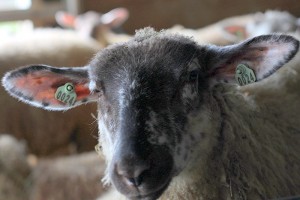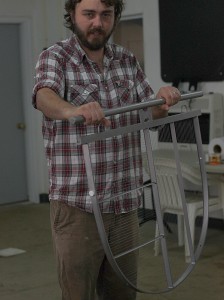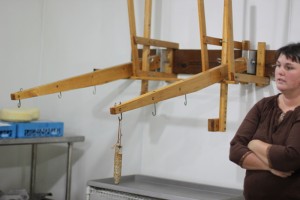On a crisp day last month, I visited Kokoborrego Cheese Company at the Sippel Family Farm with friends Bethia Woolf of Columbus Food Adventures and Faith Durand of The Kitchn. We took the hour-long drive north of Columbus to discover more about Ohio's first sheep's milk creamery.

Why Cheese?
After many years running the popular Sippel Family Farm vegetable CSA, Lisa and Ben Sippel searched for an additional, less seasonal, artisanal product. At the same time, Lisa's brother Ben Baldwin wanted to move out of the corporate restaurant management game. They found their calling to make cheese together at a workshop by Peter Dixon, a Vermont-based food educator.
The Sippels established a flock of East Fresian cross sheep in autumn 2010 and began their creamery in February 2011.
Ben Baldwin, primary cheesemaker, explained that "sheep's milk more naturally wants to be a cheese", which is why they turned to establishing a flock of sheep in addition to making cheese from a nearby family farm's cow milk. Besides, no one else in Ohio is making sheep's cheese and Lisa saw a market niche.
The name Kokoborrego comes from the Kokosing river headwaters near the farm and the Spanish word for sheep. Cheese variety names also reflect central Ohio terroir; Headwaters, Moraine, Whetstone, and Owl Creek all refer to local land and water features.
How the Cheese is Made
Ewes give milk twice daily in their 180-240 day lactation season from approximately March to September. At peak lactation, the Sippels get one gallon of milk per sheep per day. Ben Sippel is the primary milker. Ben also manages the grazing land for the ewes who eat local hay in the barn and spelt in the milking parlor.
With a heard of thirty five, Ben Baldwin makes small batches of cheese by hand three days a week.


When pH reaches the cheese-maker's desired level, Ben gently stirs in rennet. Rennet is a naturally occurring enzyme that flocculates or separates solids from liquids in the milk.
After thirty minutes or so, the milk has flocculated and it's time to cut curds. When curds are fully developed, Ben stirs the cheese for approximately thirty minutes to develop texture.
Next Ben drains the whey and forms cheese into molds. He presses the molds in the devise pictured above to further release liquid. After a few hours in the molds, the cheese is released and aged for up to six months in a climate controlled room.


The Sippels are concerned with making their farm a sustainable system and providing unique high quality products to the market. They hope to double the size of their sheep flock and make cheese more frequently in the next year.
They are adding pigs to the farm. Pigs will eat the whey (which is now poured on compost heaps) and eventually be processed and sold as artisanal pork.
While the current Kokoborrego cheese lineup is very successful, the cheesemakers are experimenting with Parmesan, Manchego and feta style cheese. A small supply of brie sold out in short time this summer.
Food lovers in Columbus can find Kokoborrego at several grocers and restaurants. Distributors in Cleveland and Chicago make the cheese available beyond central Ohio.
Bethia details more about the cheese styles and where to find them in her article Kokoborrego Cheese Company on Columbus Food Adventures.
Have you tried Ohio's first sheep's milk cheese?



